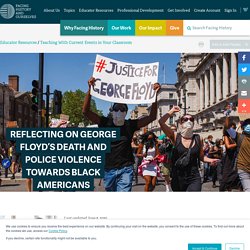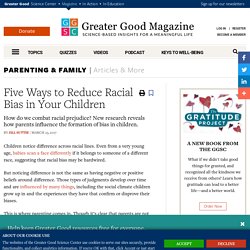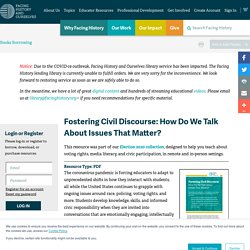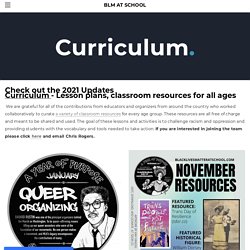

Cynthia Kuhlman
Maker, learner, teacher, mom
Integrating Inclusive Literature. Equity and Social Justice Awareness Quizzes. Are you being fooled?

I designed the Awareness Quizzes to challenge some of the false information floating around about difference and equity in the United States and the world. Equity and Diversity Awareness Quiz (2017) Downloadable Version of the Quiz in PDF Format. 26 Mini-Films for Exploring Race, Bias and Identity With Students. Conversation - 07 (Asian-American) Cut 2016-03-09 00:00 ESTHER: I think the conversations I had about race with my family was primarily lead by my dad, and it would just be in little lessons.
Queer People Have Always Existed—Teach Like It. Reflecting on George Floyd’s Death and Police Violence Towards Black Americans. For more information on our response to these events: On May 25, 2020, George Floyd was suffocated by a police officer in Minneapolis, while three other officers looked on.

George Floyd has joined a long list of black men, women, and children who have been killed in recent years by police officers. Here is a list of some of the names of black people killed by the police between Eric Garner's murder in 2014 and George Floyd's murder this year. Protests have erupted across the United States—and even across the world—in response to these deaths. This Teaching Idea is a guide for teachers to begin conversations with their students about George Floyd’s death and the events that surround it.
Anti-Bias Tools & Strategies.
Demystify Adolescence and Curate Inclusion: Puberty Resources for Diverse Youth. Research-Based Advice on Teaching Children Not to Be Racist. Make your lessons age appropriate.

It's important to tailor your message about diversity to your child's age (PDF), as we recently reported in Personality and Social Psychology Bulletin. Up until about age seven, what we say takes precedence over everything else, including children's own experiences. Beginning at around age 10, however, children's experiences start to matter more than our messages do.
What this means is that, while it's important for us to talk to our children about diversity and equality, the way we do it should evolve as our kids grow. Five Ways to Reduce Racial Bias in Your Children. Children notice difference across racial lines.

Even from a very young age, babies scan a face differently if it belongs to someone of a different race, suggesting that racial bias may be hardwired. But noticing difference is not the same as having negative or positive beliefs around difference. Those types of judgments develop over time and are influenced by many things, including the social climate children grow up in and the experiences they have that confirm or disprove their biases.
Critical Media Project. Anti-Racism Resources for All Ages. 8 Ways Teachers Can Address White Supremacy in the Classroom. Help your students build a better world with these strategies, lessons, and tools.

White supremacy, and the concept of whiteness that it relies on, grows when it goes unnamed and unchallenged. In the absence of honest conversations about race, it festers like a wound. It's more important than ever to have these tough conversations with our students. Let's be real: It might feel scary to take this plunge. Fostering Civil Discourse: How Do We Talk About Issues That Matter? The coronavirus pandemic is forcing educators to adapt to unprecedented shifts in how they interact with students, all while the United States continues to grapple with ongoing issues around race, policing, voting rights, and more.

Students develop knowledge, skills, and informed civic responsibility when they are invited into conversations that are emotionally engaging, intellectually challenging, and relevant to their own lives. Engaging in civil discourse means bringing your mind, heart, and conscience to reflective conversations on topics that matter, in ways that allow you to extend your understanding in dialogue with others. Talk About Race in the Classroom. Youtube. Helping Kids Process Violence, Trauma, and Race in a World of Nonstop News. Civil Discourse Online. Remix · Where From Poem. KQED Learn. Critical Practices for Anti-bias Education: Classroom Culture. Talking About Race. Curriculum - BLM AT SCHOOL. Check out the 2021 UpdatesCurriculum - Lesson plans, classroom resources for all ages We are grateful for all of the contributions from educators and organizers from around the country who worked collaboratively to curate a variety of classroom resources for every age group.

These resources are all free of charge and meant to be shared and used. The goal of these lessons and activities is to challenge racism and oppression and providing students with the vocabulary and tools needed to take action. If you are interested in joining the team please click here and email Chris Rogers. Here's the resource package for November, where we are engaging the principle of being TRANS AFFIRMING and joining in celebration of the Transgender Day of Remembrance scheduled for November 20.
More Diversity Activities for Youth and Adults. Introduction Why is appreciating diversity important for youth and adults? The face of the United States and its workplace is changing. A growing number of neighborhoods and communities contain a complex mix of races, cultures, languages, and religious affiliations. At the same time, the widening gap between the rich and the poor is creating greater social class diversity.